
Air Venturi Avenge-X classic wood.
Part 10, where you’ll find links to all previous reports
This report covers:
- The fill
- Magazine or single shot tray?
- The test
- Sight-in
- Lucky?
- Single-shot tray
- Back to the magazine
- Confused?
- Next
- Overwhelming
Today we start looking at the AirVenturi Avenge-X in .22 caliber. At the end of this series we want to see the rifle tuned as well as possible for one specific pellet, just like we did for the .177-caliber rifle. Today we begin searching for which pellet that is.
This report series will go in great depth and I won’t rush things. But what you will read in this series will be just a cursory look, because I have to write about many different things. I don’t have the luxury of going as deeply into a single air rifle as you readers do. But I can show you what needs to be done when you do.
I will go through this material slowly, so no one is left behind. The Avenge-X is both so accurate and also so tunable that there is a lot to consider.
The fill
Our work with the .177 Avenge-X taught us many things that can now be used to abbreviate the tuning process for the .22. The first of these is that this rifle doesn’t seems to like being filled to 300 bar/4350 psi. In Part 9 I resolved to fill it to a lower pressure and this time I dialed the RovAir Portable air compressor down just a bit. The fill went to around 4100 psi, give or take.
Because this is a .22 I may be wrong about the fill pressure. The rifle may fill all the way and just want the reg pressure set higher. I have a plan to test for that.
Magazine or single shot tray?
Trying to answer this question got me off the boat and onto the island of Serendib. What I mean by that is — this is where life kicked in and today’s report became serendipitous. I thought I was going to test the rifle one way but reality intervened and forced me to test it a different way. You will see that. Let’s look at the areas that need to be tested. All the following relate to accuracy.
1. Pellets shot on low power.
2. Pellets shot on high power.
3. Pellets shot using the magazine.
4. Pellets shot using the single shot tray.
5. And of course I’m looking for the most accurate pellet.
Do I need to test all pellets on low and high power and both with and without the magazine? I don’t think so. If I discover a bad chamber in the magazine I will go to the single-shot tray for the rest of the test. Therefore, determining whether I can trust the magazine is an important issue and should be addressed early.
How many pellets should be tested? That one is a toughie because there are so many good .22 caliber pellets on the market. I selected seven to test today, but you will learn that I didn’t get to all of them — not even to most of them. This is where the test turned serendipitous. Let’s get started.
The test
I shot from 25 yards today, but the sight-in started at 12 feet. I shot 5-shot groups all day because I thought I was going to test a lot of pellets. I did a lot of testing, all right, but the number of different pellets turned out to be small. The rifle was rested directly on a sandbag.
I shot all shots on Low power and the regulator is still set to 145 bar, which it was for the .177 barrel test. I will be changing the reg later in this series, but that will come after we find the best pellet to test.
Sight-in
I sighted in with 18.13-grain JSB Exact Jumbo Heavy pellets. There was no special reason for choosing that pellet. You just have to start somewhere.
The scope was removed for the barrel swap, and, of course, so was the barrel. Therefore the first thing was to sight the rifle in. And to my complete surprise — it already was! One shot at 12 feet and the pellet hit exactly where I wanted it to — below the bull and centered left and right. Apparently that locating pin on the receiver locates the barrel shroud exactly where the rifle wants it to be!
The target below shows the sight-in shots below the center of the bull that was the aim point. The highest hole was shot at 12 feet and the next two from 25 yards. After seeing where the 25-yard pellets landed I dialed into the scope some up elevation and shot a five-shot group. This 25-yard group measures 0.31-inches between centers. Once more I point out that this group that is pretty good for most air rifles is just okay for the Avenge-X!
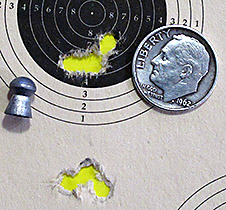
The three sight-in pellets are below the bullseye. The first shot was from 12 feet and the next two were from 25 yards. The five-shot group is inside the bullseye. Shot number 7 (which includes the three sighters) landed high and right in the group. The other four pellets are below it and to the left. This 25-yard group measures 0.31-inches between centers.
Lucky?
Did I learn something already? Is chamber number 7 in this 10-shot rotary magazine misaligned? I don’t know yet, but I will watch it. I shot the two pellets that remained in the magazine at the target box just to clear the mag and then I replaced it with the single-shot tray. Maybe I will get lucky with this first pellet and not use the rotary magazine anymore.
Single-shot tray
I next loaded and shot five more JSB Jumbo Heavys using the single-shot tray. These five pellets went into 0.596-inches at 25 yards. Cowabunga! This group is LARGER than the magazine group I just shot? I didn’t expect that! Okay, maybe the magazine is the way to go. I don’t see why the singly-loaded pellets made a larger group though, UNLESS — the Avenge-X just doesn’t like this Low-power tune for this particular JSB pellet and the magazine somehow corrected for that. This one is a real puzzlement. The only explanation I can see is that when I filled the rifle this time it was still filled too high and had not come onto the power curve until the middle of this string.
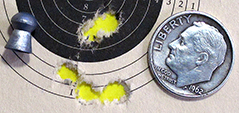
Well THAT didn’t work! At 25 yards 5 JSB Jumbo Heavys are in 0.596-inches between centers.
Back to the magazine
Since the single-shot tray didn’t seem to work I went back to the rotary magazine. I loaded five RWS Superdomes, followed by five Benjamin Bullseyes. I shot the Superdomes first. Five went into 0.395-inches at 25 yards, which is no big deal for the Avenge-X.
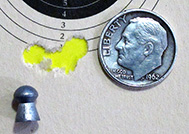
Using the mag the rifle put five RWS Superdomes into a 0.395-inch group at 25 yards.
Next came the five Benjamin Bullseyes. The first two went wide apart, but the all the rest of the pellets went back into the hole made by the first pellet. It seemed very likely at this point that chamber number seven in the magazine was out of alignment. Five shots are in 0.547-inches, with four in 0.217-inches.
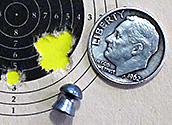
At 25 yards the rifle put five pellets into 0.547-inches with four in 0.217-inches. Chamber number seven seems to be misaligned.
After seeing this target I had to know if chamber seven really was misaligned. So the mag came out a second time and I inserted the single-shot tray again. I shot five singly-loaded Benjamin Bullseyes and this time I got what I was looking for. At 25 yards five pellets made a 0.328-inch group.
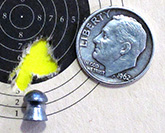
When shot from the single shot tray, five Benjamin Bullseyes went into 0.328-inches at 25 yards.
What has been learned?
First, I will lower the initial fill level a bit more next time, because the double group we see with the JSB Jumbo Heavys seems to warrant it.
Next, shooting on Low power doesn’t seem that good. I think the pellets need more of a push.
After that, the regulator may be set too low. But I need to shoot these same pellets on High power at the current reg setting to determine that. And before I do that I need to find an accurate pellet I can rely on.
Confused?
It seems like you can’t tell anything from today’s tests. But we have discovered what doesn’t work, and that’s a start. We also suspect that chamber number seven in this particular rotary magazine is out of alignment, but that’s not yet certain.
The Benjamin Bullseye pellet seems to have potential in this caliber (the group of four in the second-to-last target) so I will continue to shoot it as we start varying things like the fill pressure and the reg pressure. And don’t forget — there are another four pellets we have to test.
Next
I want to establish that chamber seven is out of alignment, and I think the best way to do that is to shoot a ten-shot group of the most accurate pellet tested thus far without changing any of the settings. That would be the Benjamin Bullseye. I’ll even leave the fill pressure where it is for now, until I have shot that 10-shot group.
If the first 10-shot group has a separation of pellets (at least two groups in slightly different places and probably one above the other) I will shoot a second group of ten with the same Bullseye pellet from that magazine. And I may shoot a third group with the same pellet and still using the magazine, but with the rifle set on High power.
I may shoot additional groups after these three, but until I see the results I can’t say anything for sure.
Overwhelming
If all of this seems overwhelming, please remember what we are doing. I am walking you step-by-step through a testing procedure to set up the .22-caliber Air Venturi Avenge-X rifle for the same kind of tuning we did with the .177 rifle. There are just a lot of things we have to know before starting that procedure. Fortunately the barrel locating pin takes barrel alignment out of the equation.
I’m not going to summarize today’s report because we haven’t learned enough to summarize. You have looked over my shoulder at the process and nothing has been withheld. At this point you know just as much as I do about the .22-caliber Avenge-X that I’m testing.

Fortunately, I am not under the same time constraints as you.
But I share the same problems with the Avenge-X.
Where to start, and what projectile to start with.
And ultimately, when do you stop?
It’s kind of like painting a picture, how do you know when is it finished?
Ian
“You have looked over my shoulder at the process and nothing has been withheld.”
BB,
Yes, we have; and it’s an interesting process, for sure.
“At 25 yards the rifle put five pellets into 0.547-inches with four in 0.217-inches. Chamber number seven seems to be misaligned.”
Man, the picture sure seems to bear that out; it’ll be interesting to see your 10-shot groups..
I’m glad it’s you doing all this work and not me; I’m tired just from reading all you had to do, LOL!
And you’re not even close to being done yet! 😉
Blessings to you,
dave
A guy at the range has one in .22. He says it is dead nuts accurate at 100 yards.
-Yogi
Tom,
This is going to be a Neverending Test. SO many variables that can affect accuracy. I’m sure glad that you are approaching and documenting everything systematically so that the other owners after screwing up the tuning have a roadmap to follow in getting their own rifles back on track. I wonder how you will conduct the test of chamber 7 for accuracy?
Siraniko
These days I rarely use magazines in any of my PCP rifles. The DAR Gen 3 has the most dramatic difference in the way it shoots using a SST, I think the receiver is at fault and not the mags as all six DAR mags work poorly in it and much better in my Gen 2. I’ve had to seek out after market SST’s as Origins and DAR’s do not come with them. Pyramid has very nice metal ones for Avenger/Origin rifles and I found some for the DAR’s on the Bay. Wither it is alignment, time for pressure in the plenum to settle or the fact we shoot slower single loading that is the major factor in accuracy I cannot tell but for this old guy single loading is better and more enjoyable.
I’m guessing the issue with pellet no7 is less about alignment but probably a burr on the magazine rotor. Easy way to check is to load the magazine and push each pellet out while looking for damage to them
When I was a kid going on road trips with the family there were often games we would play: I spy, cow poker, etc. Once old enough, I usually preferred to be “the navigator” reading the road maps (remember those?) and directing the driver. The point is that we need to enjoy the trip itself instead of just being focused on “are we there yet?”. And this “trip” exploring the AvengeX looks like it will be quite an extended adventure. I for one am enjoying the trip. Thanks BB!
I too always enjoy BB’s “trips”.
FM “thirds” that – one also learns what trips to avoid with a particular airgun.
Count me as fourth enjoying the trip, with no rush to get to the end.
Henry
Another vote for continuing with BB’s “road trips”. He breaks them up with a lot of stops on the way. Even exploring a few back roads when they appear promising.
Well, I think I have belabored the analogy enough for today. I am becoming more enabled every day about this rifle. Just like a painting, as mentioned by Ian, you never know when you’ve finished acquiring airguns either.
BB,
I can sympathize with you as I have just begun to piddle with my .25 Armada. I will likely end up going through this same “mess” with it except it does not have a regulator. I do have a SST (single shot tray) and two magazines for it. Somewhere along the line they will have to be tested.
I am also going to have to decide whether I want to tune this “down” to operate at around 2000 PSI or do I want to tune it “up” to use “slugs”. I may actually be able to do both. I have no idea. The lower fill pressure would be nice though.
I really have absolutely no idea how this thing is tuned (or mistuned for that matter), which means I am going to have to do a bit of reading and then break out the old chrony to see what it is doing. As it does not have a regulator, I will have to do that shot curve thing also.
Will I bore all of you and write about all this? There is a pretty good chance. If nothing else, it will help me keep track of what I am doing. Will BB put this on his blog? We will see. It is not that he does not have enough headaches right now with that Avenge-X.
I have always wanted a Marauder. This .25 Armada gives me that AND a black rifle to boot. I do wish it was a .22, but it was a pretty good deal and I do not have anything else in that caliber. I intend to stretch its legs a good bit. One way or another I will let you folks know how things are going with it.
RidgeRunner,
Please do bore us with your journey on your new to you Armada. Hopefully the destination will be very fruitful.
Siraniko
Siraniko,
If BB does not use it, I will at least let you folks know what is going on with it.
BB, Do the magazines for the Avenger X fit the Avenger? Are they the same mag? I ask because I switched to using CARM magazines with my Avenger and never looked back. They are head and shoulders better than the stock mags. If they are the same mag for both guns, I can send you one to test with the X, as long as I get it back when you are done haha.
CARM makes magazines for many many air rifles, including high end ones and I think covering them would make a great blog in and of itself, but it seems particularly prudent with this gun and your possible no 7 issues. Let me know…
Bob
Bob,
I’m pretty sure they are the same.
BB
Ridgerunner, you are trading one evil for another.
No regulator true, but you have an infinitely adjustable transfer port that the Avenge-X does not have.
Trading one type of metering device for a different one. Hmm…
Ian.
Ian,
This is true to a point. As I pointed out, I wish to “tune” it to around 2000 PSI fill pressure. If I can then “tune” it to use cast bullets (slugs to the unwashed and uninitiated) that will be great. If I have only two or three sub-MOA at 100 yards, that will be fine. I am not one to those who need a gazillion shots per fill.
There are guides available for tuning to just about any setting I may want. There are also gee gobs of after market parts and kits for this air rifle which are not available as of yet for the Avenge-X. Another plus is this is made in the USA.
RidgeRunner,
Does yours have the MAGPUL MOE butt stock?
You should be able to get three or more full power shots in the 40+ FPE range. I would try for bullets the H&N Slugs; Pair has some but “sister” Airgun Depot has a MUCH larger .25 bullet selection.
You will have fun…hopefully not become overwhelmed…
kind of doubt it.
shootski
PS: H&N SLUG Samplers come in two sizes .249 and .250 and a range of weights that will help you find the best bullet. You probably already knew that…
shootski,
I have no clue as to which butt stock it has. That I will likely be changing to one similar to what is on the Brococks. I like the minimal stock look. First thing I must do is do a total shot curve and see where it is right now, then go from there.
RidgeRunner,
https://magpul.com/moe-carbine-stock-mil-spec.html?mp_global_color=118
You need to screw OUT the Transfer Port (TP) restrictor screw from full IN about 4-5 turns; just not too much/all the way out to get maximum FLOW for power then return the locking screw with as little turbulence as possible. (If it was me setting up any airgun for one projectile with a TP restrictor screw i would go to a custom NO ADJUSTMENT TP to avoid the turbulence induced by the screw/hole right before the barrel.) Since you are not interested in Shot Count it would be the last thing i would mess with to get rid of wasted air. The Hammer-Striker (H-S) Length Overall is the power level Elephant in the action. For MAX power you want it as LONG as possible since it will knock open the valve sooner regardless of the Preload level on the spring. For LOW power you want the H-S length as short as possible.
You can then tune for the projectile accuracy with the H-S spring (the most accessible as well as most logical fine adjustment) and you run less risk of peening the valve stem on the high end. If your gun “burps” you can get rid of that by throttling the TP in small increments with the screw or better with a smaller internal diameter TP.
JUST MY OPINION for your consideration.
shootski
shootski,
Thanks for this info. I believe this air rifle is going to be quite a journey. I for one am looking forward to it.
I once had a .22 caliber Gen 2 marauder.
I bought it used, the previous owner had tried to “tune” it and it was basically non functional on arrival.
I threw everything I could at it trying to get it to shoot accurately with a factory spec 2800 psi fill, nothing worked, and every pellet I could put my hands on.
After much trial and error, I eventually stumbled on a 2000 psi fill, for 20 shots. Shooting the crosman premiers. I don’t remember the numbers.
But it was a great 25 yd squirrel gun for many years.
I sold it to a friend in Mississippi, he wanted more Fpe.
I had told him of my problems getting it to shoot higher, but he tried anyway.
3 months later he called to say he had gone back to my settings as nothing else would work.
He still owns it, and enjoys many fills off of his small “guppy” sized 4500psi fill bottle.
Sometimes you just have to let the gun run where it wants to be happy…
Ian.
Ian,
We shall see where it goes. As I have said, 2000 PSI fill pressure is my goal. I also desire to make this my “slug” gun. The fill pressure can be adjusted and the output power also. The shot count to me is really immaterial.
We shall see what we shall see.
RidgeRunner,
2000 PSI is plenty of input pressure for a few STOCK GUN MAXIMUM possible power shots with the powerplant (valve) balanced for the projectile of choice.
I believe you and your Chronograph and Groups will guide you to that.
I look forward to your results.
shootski
shootski,
I am a big fan of “low” pressure. We have forgotten so much of how it was done over the years. This is one of the reasons I enjoy the “antiques”.
RidgeRunner,
Have you seen the collection of BRK Exploded Parts Diagrams? I was blown away by the number of parts and the quantities of O-Rings and other gland seals floored me!
To think that the first generation of PCP builders didn’t have CNC machines, 5 axis mills, or even electricity yet were able to build powerful and accurate airguns with a much smaller number of parts with NO (not even one) O-Rings!
LOL!
shootski
shootski,
K.I.S.S.! We have forgotten so much in how things were done, not just the airgun world. A prime example is Microsoft. Once upon a time we used to make programs as compact as possible, but with the advent of larger capacity, Microsoft and others have just been adding patches to cover their mistakes rather than correcting them. This is why programs are so large. Just plain laziness. No real thinking involved. Let us solve a problem rather than solve the problem.
In the world of airguns, someone decided that we needed more shots. Since the increase in volume presented issues, let us increase the pressure inside the same volume. Let us add a regulator to decrease the pressure to something the valve can use. The regulator or in some cases regulators need to be more precise. The valve needs to be more precise in the metering of air. The hammer/striker needs to be better. Yada, yada, yada. Add each of these “fixes” to the design.
I guess this is what attracts me to the old way of doing things. Use of brain matter to do more than maintain the distance between ears.
RidgeRunner,
Could not have said it any better!
Have sadly seen the Programer ABUSE of processing and storage power increases since first contact with computers in the 70’s. I remember telling Programers you have only three chances to patch this program or you get to start over from scratch. The use of pre programmed/utility subprograms is at criminal levels.
I won’t even touch the ABUSE of fast and vast memory of all types.
shootski
B.B.,
“Overwhelming” NICE ;^)
Your back to doing OT&E.
All i can do is tell you is your job is to find the flaws, or at least as many as possible, for the developers to correct is your best bet. It saves future buyers from having to find them in their newly purchased airgun.
How to set up the airgun can wait until most of the PROMPT flaws have been found, rectified, or work arounds found. Of course the final workaround is to return it to the seller if needed.
The magazine(s) appear to be a PROMPT flaw area of concern. If you had three for each caliber barrel you could do it much quicker and i believe more conclusively.
The only other thing i would point to is that (in my opinion based on ALL the gas laws) filling with air above 250 BAR ( 3625 psi) is not needed, is unnecessarily abusive to: single stage regulators consistency/cost of multiple or step down regulators, compressors, hand pumps/operators, air reservoirs, and finally perhaps most importantly, the PCP buyers wallet. The added shot count above 250 BAR is insignificant and the added potential power is typically negated by the regulator(s) settings.
For buyers of this type of PCP knowing what you want to do with it is the way to the light. It and B.B.s testing is going to keep you from doing OT&E (Operational Test & Evaluation) unless you want to! It should tell you what pellet or bullet (slug) weight and in what caliber to start.
Just a few thoughts that might help you and PCP buyers.
shootski
PS: looking forward to the future testing you report on!
BB,
The Avenge-X is an infinity variable (within it’s functional range) airgun. Unless you decide what you want to tune it to you can spend forever randomly trying things – that can be a fun game of “what if” but I don’t think you have time for that.
A couple of comments if you don’t mind…
– searching for the best pellet is not going to be fruitful at this point in time – the second you touch the regulator setting EVERYTHING CHANGES and you have to start over!
– stick with the single shot loader (check it seats solidly and has no burrs) or better yet hand load the pellets so you can feel if there is a burr on the bore or transfer port (I had to deburr the TP on my Avenge-X). Don’t use the magazine, each chamber is an unproven variable, for all you know, #7 might be the only good one!
– Ideally, the PCP is well broken in before you start serious tuning.
Suggestions…
– Pick a path. Decide if you want to tune to low (13 grain), medium (16/18 grain) or high (25 grain) power and choose the appropriate projectile.
– With the hammer spring tension set at a mid-point (to allow up and down adjustments), setup the regulator pressure to get a velocity slightly below what you expect to give the appropriate performance.
For a mid power tune I’d choose an 18 grain JSB and adjust to around 850 fps as a start and rough tune for best groups which I would expect to come in the 880-900 fps range. Monitor velocities for consistency, watch pellet flight for stability and listen if air is being wasted. Low ES and SD is nice but consistent flight takes precedence.
While rough tuning I might try different brands of 18 grain pellets or even a 16 grain pellet just to see what is happening.
Ideally, you would fingerprint this “new to you” PCP to get a feel for the reg, hammer, transfer port controls and know where the power curve was. Fingerprinting takes some time but saves time in a long run.
– With rough tuning done I fine tune to a setting that is 3-5% below the knee of the power curve to make the PCP more stable and less sensitive to changes in pellet weight, temperature or pressure.
Once tuning is done and the airgun is shooting consistently then, after inspecting the magazine for flaws, I’d check to see if the magazine was a source of fliers. I use sorted pellets to minimize variables for this.
With a fixed power PCP you have to find what pellet suits the factory tune, with an adjustable PCP you choose the appropriate pellet for the application and tune to make it shoot consistently.
Hope this removes a lot of the variables and makes things simpler for you.
Hank